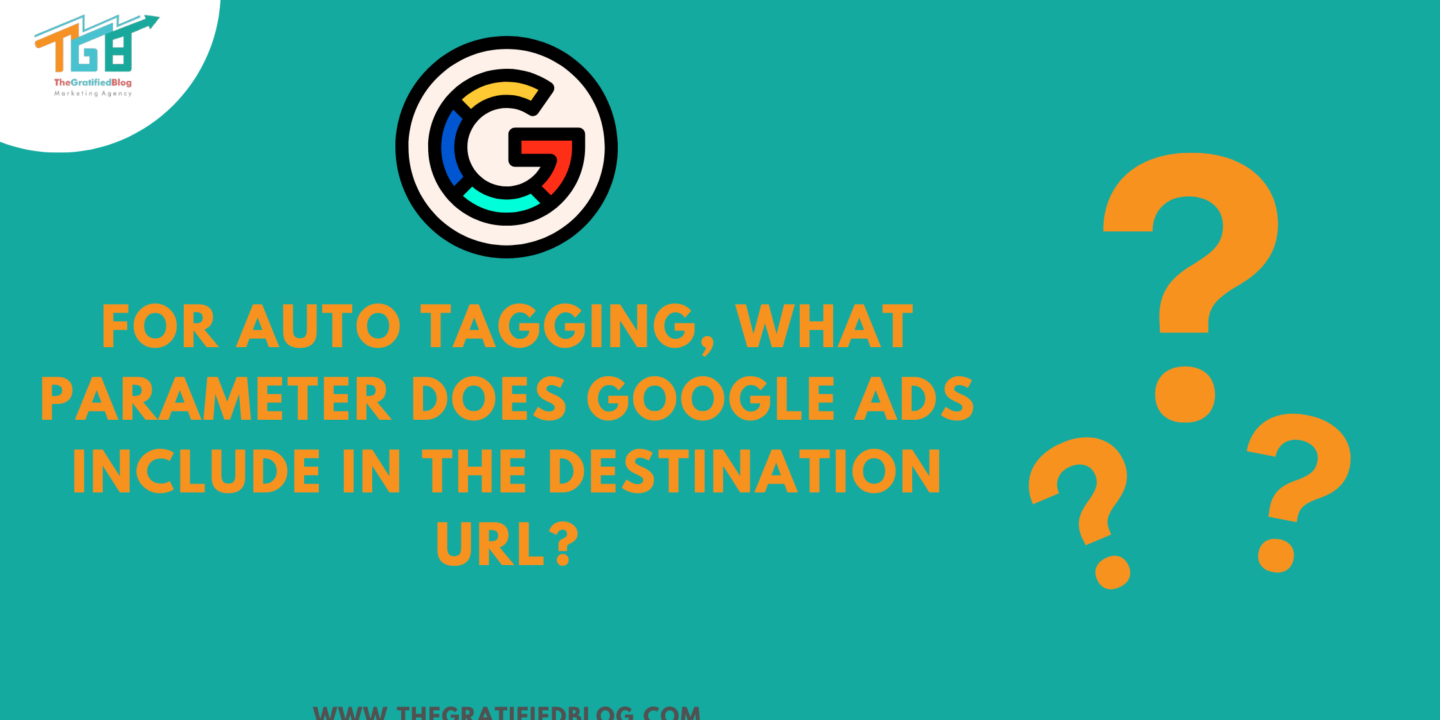
In the intricate world of digital advertising, tracking and measuring the success of your campaigns is paramount. Every click, every interaction, and every conversion matters. That is where the concept of “auto-tagging” comes into play, revolutionizing how we analyze the performance of Google Ads campaigns. Have you ever wondered, “For Auto tagging What parameter does Google Ads include in the destination URL for auto-tagging?” This question unveils a crucial mechanism that enables advertisers to gain precise insights into the effectiveness of their ads.
In this blog, we’ll delve deep into the world of auto-tagging, explore the specific parameter Google Ads includes in the destination URL, and unravel the significance of this seemingly cryptic piece of data. So, Buckle up as we embark on a journey to understand how this parameter empowers advertisers with invaluable data, allowing them to fine-tune their strategies and achieve optimal results.
So, let’s get started;
What Is The Auto-Tagging Parameter?
The auto-tagging parameter is a crucial element of Google Ads’ tracking system that facilitates accurate monitoring of ad performance. Upon clicking a Google Ads ad, when a user clicks this parameter, known as the “gclid” (Google Click Identifier), it is automatically appended to the destination URL.
The “gclid” parameter is a unique identifier with essential information about the ad click, campaign, ad group, and other relevant details. This information is transmitted to Google Analytics, enabling advertisers to analyze user behavior and campaign effectiveness seamlessly.
How Auto-Tagging Works In Google Ads
- User Clicks on Ad: Upon clicking on a Google Ads ad, they are directed to the advertiser’s website. Simultaneously, the “gclid” parameter is added to the destination URL.
- “gclid” Parameter Inclusion: The “gclid” parameter is a specialized code unique to each ad click. It contains encrypted data identifying the specific ad, campaign, and other tracking information associated with the click.
- Transmitting Data to Google Analytics: Upon reaching the advertiser’s website, the “gclid” parameter is recognized by Google Analytics. It deciphers the encrypted data and associates it with the relevant ad campaign, ad group, and keyword.
- Tracking User Interaction: Google Analytics uses the “gclid” parameter to track user interactions on the website, such as page views, conversions, time spent, and other relevant metrics. This data is attributed to the original ad click, providing insights into the user’s journey.
- Data Analysis: Advertisers can access detailed reports in Google Analytics, where they can analyze the performance of their Google Ads campaigns. They can evaluate which keywords, ads, and campaigns generate the most engagement and conversions.
- Optimizing Strategies: Armed with accurate data from auto-tagging, Advertisers can make strategic decisions to enhance the performance of their campaigns. They can allocate budgets effectively, refine targeting strategies, and create more tailored ad experiences.
Now that we understand the auto-tagging parameter and its operation, let’s focus on the specific parameter that Google Ads incorporates into the destination URL.
For Auto Tagging What Parameter Does Google Ads Include In The Destination URL?

Indeed, while we’ve explored this parameter earlier, let’s briefly delve into it again. When it comes to auto-tagging in Google Ads, the specific parameter that is included in the destination URL is known as the “gclid” parameter. “gclid” stands for “Google Click Identifier.” This parameter is a unique alphanumeric code generated by Google Ads for each click on an ad. It is appended to the destination URL of the clicked ad, allowing Google Analytics to track and associate user interactions on the advertiser’s website with the original ad click.
Inclusion Of The “Gclid” Parameter
Upon a user clicking on a Google Ads ad, the “gclid” parameter is automatically added to the destination URL of the landing page. This happens seamlessly behind the scenes, without any visible changes to the user. The “gclid” parameter appears as a query string within the URL and carries encrypted data that holds valuable information about the ad click, such as:
- The specific ad that was clicked.
- The campaign that the ad belongs to.
- The ad group associated with the click.
- Other relevant tracking details.
Including the “gclid” parameter is the cornerstone of Google Ads’ auto-tagging mechanism. It enables advertisers to track user interactions accurately and connect them with specific ads, campaigns, and ad groups within Google Analytics.
Significance of the “Gclid” parameter
The “gclid” parameter holds immense significance for advertisers using Google Ads for several reasons:
- Precise Attribution: The “gclid” parameter ensures accurate attribution of user actions to the originating ad click. This level of granularity allows advertisers to understand which ads, keywords, and campaigns drive valuable user interactions and conversions.
- Streamlined Tracking: Manual tagging becomes unnecessary with the “gclid” parameter. This streamlines the tracking process, reducing the risk of human errors and saving time advertisers can allocate to more strategic tasks.
- Comprehensive Analytics: By integrating with Google Analytics, the “gclid” parameter enriches the data available for analysis. Advertisers can delve into user behavior, measure engagement, and evaluate the effectiveness of their campaigns with a comprehensive dataset.
- Optimization Insights: Advertisers can make informed optimization decisions with accurate data from the “gclid” parameter. They can adjust bidding strategies, refine ad copy, and Allocate budgets for the optimal return on investment.
- Cross-Channel Tracking: The “gclid” parameter can also be utilized for tracking conversions across different marketing channels, helping advertisers understand the holistic impact of their campaigns.
Now, let’s delve into the advantages of utilizing gclid parameters.
Benefits Of Using Auto-Tagging And The “Gclid” Parameter
Auto-tagging, facilitated by the “gclid” parameter, offers a range of substantial benefits that contribute to more effective ad campaign management and optimization. Let’s explore these benefits in detail:
Accurate tracking of ad campaign performance
- Granular Attribution: The “gclid” parameter enables precise attribution of user interactions to specific ads, campaigns, and keywords. This granularity empowers advertisers to identify the exact sources of conversions and understand which components of their campaigns are most effective.
- Conversion Insights: Advertisers can gain insights into user behavior patterns by tracking the entire user journey, from ad clicks to on-site actions. That allows for a deeper understanding of conversion paths and the ability to optimize campaigns accordingly.
- Keyword Performance: Auto-tagging with the “gclid” parameter provides data on keyword-level performance. Advertisers can analyze which keywords drive the most valuable clicks and conversions, allowing them to allocate budgets strategically.
- Ad Copy and Design: Accurate tracking facilitated by the “gclid” parameter allows advertisers to assess the performance of different ad copies and designs. This data-driven approach helps refine messaging and visuals for optimal results.
Simplification of URL management
- Error Reduction: Auto-tagging eliminates the need for manual URL tagging with UTM parameters. This reduces the likelihood of human errors in URL configuration, ensuring accurate data collection and analysis.
- Time and Effort Savings: Manual tagging can be time-consuming, especially for more extensive campaigns. Auto-tagging with the “gclid” parameter streamlines the process, saving advertisers significant time and effort that can be redirected toward more strategic tasks.
- Consistency: Auto-tagging maintains consistency in tracking parameters across all ads, campaigns, and platforms. This consistency enhances data accuracy and makes campaign management more organized.
Enhanced Google Analytics integration
- Seamless Data Flow: The “gclid” parameter seamlessly integrates Google Ads with Google Analytics. This integration ensures click data is transmitted accurately and promptly, allowing advertisers to analyze user behavior confidently.
- In-depth Analytics: The “gclid” parameter enriches Google Analytics data by associating on-site actions with specific ad clicks. This provides a comprehensive view of user engagement, Bounce rates, duration of visit, and conversion rates, facilitating a more detailed analysis.
- Multi-channel Insights: Integrating the “gclid” parameter with Google Analytics allows advertisers to track conversions across various channels. This holistic view enables a better understanding of the customer journey and the impact of cross-channel interactions.
- Custom Reporting: The “gclid” parameter data can be used to create custom reports and segments in Google Analytics. This flexibility enables advertisers to tailor their analysis to specific goals and objectives.
Having gained an understanding of its advantages, let’s now explore the process of implementing and analyzing gclid parameters.
Setting Up Auto-Tagging
Setting up auto-tagging and analyzing results
Implementing auto-tagging and effectively analyzing the results are crucial steps to harness the power of the “gclid” parameter. Let’s explore how to set up auto-tagging in Google Ads and track and analyze the “gclid” parameter in Google Analytics.
Enabling auto-tagging in Google ads
- Log into Google Ads: Sign in to your Google Ads account.
- Accessing Account Settings: Click the gear icon in the upper right corner and click on “Account settings.”
- Preferences: Under the “Tracking” section, find the “Auto-tagging” option.
- Enable Auto-Tagging: Check the box to enable auto-tagging.
- Save Modifications: Ensure that you save any adjustments you make.
With auto-tagging enabled, Google Ads automatically append the “gclid” parameter to your ads’ destination URLs when clicked.
Conclusion
Given your comprehension of “For Auto Tagging, What Parameter Does Google Ads Include In The Destination URL?”, why not take the opportunity to put it into practice? Embrace it today and witness its functionality firsthand.
If you have any questions regarding this topic, please leave them in the comment section. Feel free to ask any questions; we are here to provide answers.
Thanks for reading 🙂








No Comments